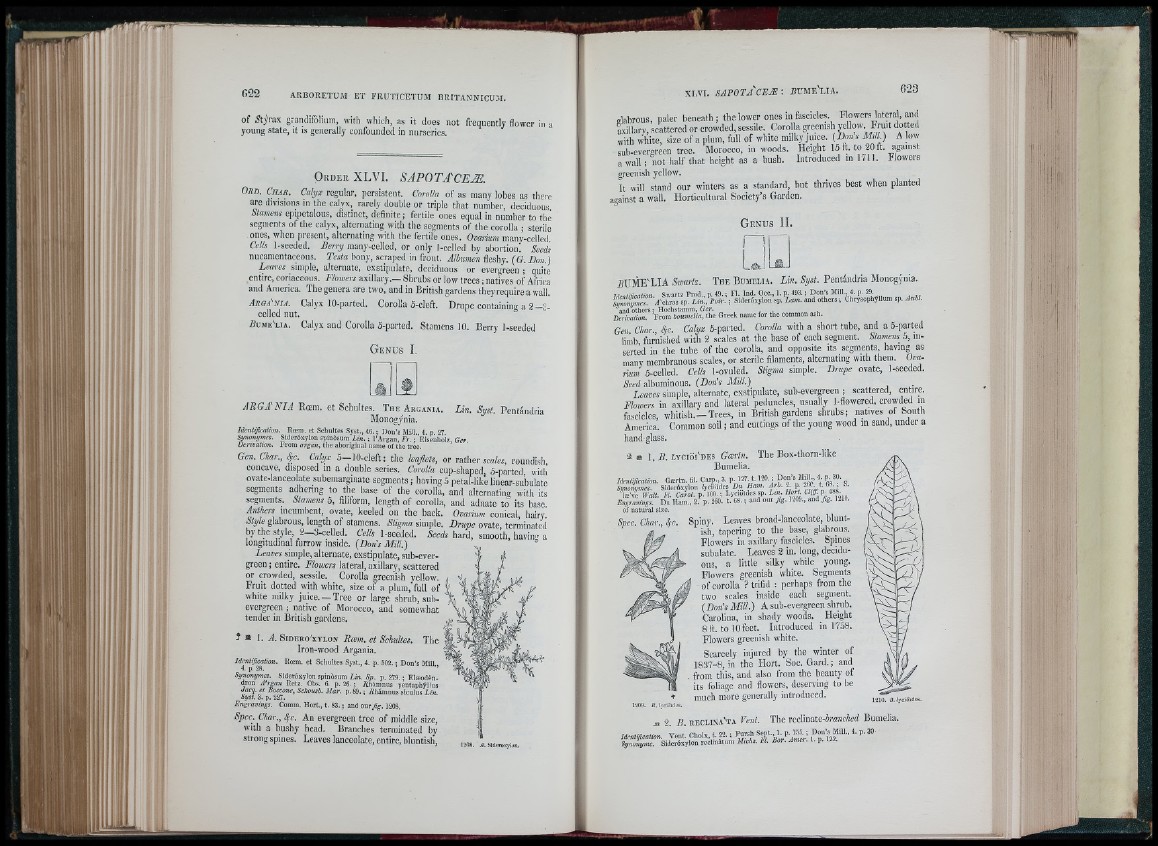
f
of StjJrax granclifoliiim, with which, as it does not frequently flower in
young state, it is generally confounded in niirserios.
O r d e r XLVI. SAPOTAlCEM.
Ord. Char. Calyx regular, persistent. Corolla of as many lobes as there
are divisions in the calyx, rarely double or triple that number, deciduous
Stamens epipetalous, distinct, definite; fertile ones equal in number to the
segments of the calyx, alternating with the segments of the corolla ; sterile
ones, when |iresent, alternating with the fertile ones. Ovarimn many-celled
Cells 1-seeded. Berry raany-celled, or only 1-celled by abortion. Seeds
nucanientaceous. Testa bony, scraped in front. Albumen fleshy. (G. Dan )
Leaves simple, alternate, exstipulate, deciduous or evergreen ; quite
entire, coriaceous. Flowers axillary.— Shrubs or low trees ; natives of Africa
and America. The genera are two, and in British gardens theyrequire a wall.
Arga' nia. Calyx 10-parted. Corolla 5-cIeft. Drupe containino-a 2 — -
celled nut. “
r t u M E 'L iA . Calyx and Corolla S-parted. Stamens 10. Berry 1-sceded
G e n u s I.
ABGA'KIA Rcem. et Schultes. T h e A e g a n i a . Lin. Syst. Pentándria
!, Ger,
Monogynia.
Identification. Roem. ct Schultes Syst., 46. ; Dou’s Mill., 4. p. 27.
Synonymes. Sideróxyloii spinòsum Lin. ; I’Argan, Fr. ; Eisenholz, <
DertvaUon. From organ, the aboriginal name of the tree.
Gen. Char., f r . Calyx S—10-cleft: the leaflets, or rather scafes, roundish
concave, disposed in a double series. Corolla cup-shaped, S-parted, with
ovate-lanceo 1 /e subemarginate segments ; having 5 petal-like linear-subulate
segments adhering to the base of the corolla, and alternating with its
segments. Stamens 5, filiform, length of corolla, and adnate to its base
Anthers incumlient, ovate, keeled on the back. Ovarmm conical, hairy
fryle glabrous, length of stamens. Stigma simple. Drupe ovate, terminated
/ t h e style, 2—3-celled. Cells I-seeded. Aecds hard, smooth, havin-a
longitudinal furrow inside. (Don's Mill.)
Leaves simple, alternate, exstipulate, sub-evergreen
; entire. Flowers lateral, axillary, scattered
or crowded, sessile. Corolla greenish yellow.
Fruit dotted with white, size of a plum, full of
white milky juice. — Tree or large shrub, subevergreen
; native of Morocco, and somewhat
tender in British gardens.
f * 1. J . SlDERO'XYLON Rcem. et Schultes. The
Iron-wood Argania.
Idcmtifimtion. Rcem. et Schultes Syst., 4. p. 502.5 Don’s Mill.,
Synonymes. Sideroxylon spinòsum Lin. Sp. p. 279. ; Elsodén-
dron A'rgan Retz. Obs. 6. p. 26. ; .Rhámnus pentaphJlUis
Boccone, Schousb. Mar. p. 89. ; .ñhámnus siculus Lin.
Engravings. Comm. Hort., t. 83. ; and our Jig. 1208.
Spec. Char., 4c. An evergreen tree of middle size,
with a bushy head. Branches terminated by
strong spines. Leaves lanceolate, entire, bluntish, ^ siaerox fon
with white, size ot a plnni, luii ot wnue imiwy jmcc.
sub-evergreen tree. Morocco, in woods. Height 15 ft. to 20 ft. against
a wall ; not half that height as a bush. Introduced m I f l l . Floweis
£rreenish yellow.
i t will stand our winters as a standard, but thrives best when planted
against a wall. Horticultural Society’s Garden.
G e n u s II.
I
1 StóK— -----
rtUME'LIA Swartz. T h e B d m e l i a . Lin. Syst. Pentándria Monogynia.
and others ; Hochstainm, Gcr.
DÍrivalion. From boumclia, the Greek name for the common ash,
Gen Char f r . Caiyx 5-parted. Ccyrolla with a short tube, and a 5-partcd
liiiib fur’nished with 2 scales at the base of each segment. Stamens 5, inserted
in the tube of the corolla, and opposite its segments, having as
many membranous scales, or sterile filaments, alternating with them. Ovarium
5-celled. Cells 1-ovuled. Stigma simple. Drupe ovate, 1-seeded.
Seed albuminous. (Doris Mill.)
Leaves simple, alternate, exstipulate, sub-evergreen ; scattered, entire.
Flowers in axillary and lateral peduncles, usually I-flowered, crowded in
fascicles whitish.— Trees, in British gardens shrubs; natives ot South
America. Common soil; and cuttings of the young wood in sand, under a
handglass.
® ffi 1. 13.-L y o io T d e s Gwrin. The Box-thorn-like
Buraelia.
Identification. Gairtn. fil. Carp., 3. p /2 7 , t. 120. ; ^ o n ’s Mill., 4 p. 30.
Synonv7nes. Sideróxylon /ycic.ldes Bit Ham. Arb. 2. p. 260. t. 68. , S.
Iffl've Walt. hi. Carol, p. 100.; Lycioldes sp. Lm. Hort. P ./S f.
Engravings. Du Ham., 2. p, 260. t. 68.; and our fig. 1209., and fig. 1210.
of natural si--
Spec. Char., 4i- Spiny. Leaves broad-lanceolate, bluntish,
tapering to the base, glabrous.
Flowers in axillary fascicles. Spines
subulate. Leaves 2 in. long, deciduous,
a little silky while yonng.
Flowers greenish white. Segments
of corolla ? trifid : perhaps from the
two scales inside each segment.
(Doris M ill.) A sub-evergreen shrub.
Carolina, in shady woods. Height
8 ft. to 10 feet. Introduced in 1758.
Flowers greenish white.
Scarcely injured by the winter of
1837- 8, in the Hort. Soc.Gard.; and
from this, and also from the beauty of
its foliage and flowers, deserving to be
much more generally introduced.
1209. fi. fyciii'ulos.
A. 2 B. beolina'ta Tent. The rcclinate-iianrM Bumelia.
I d c n m a U o n . Cholx, t. SS. ; P a /
SynÀwne. SldciAxylon rcclmàtum Miete. I'l. Bor. Amer. I. p. 112.